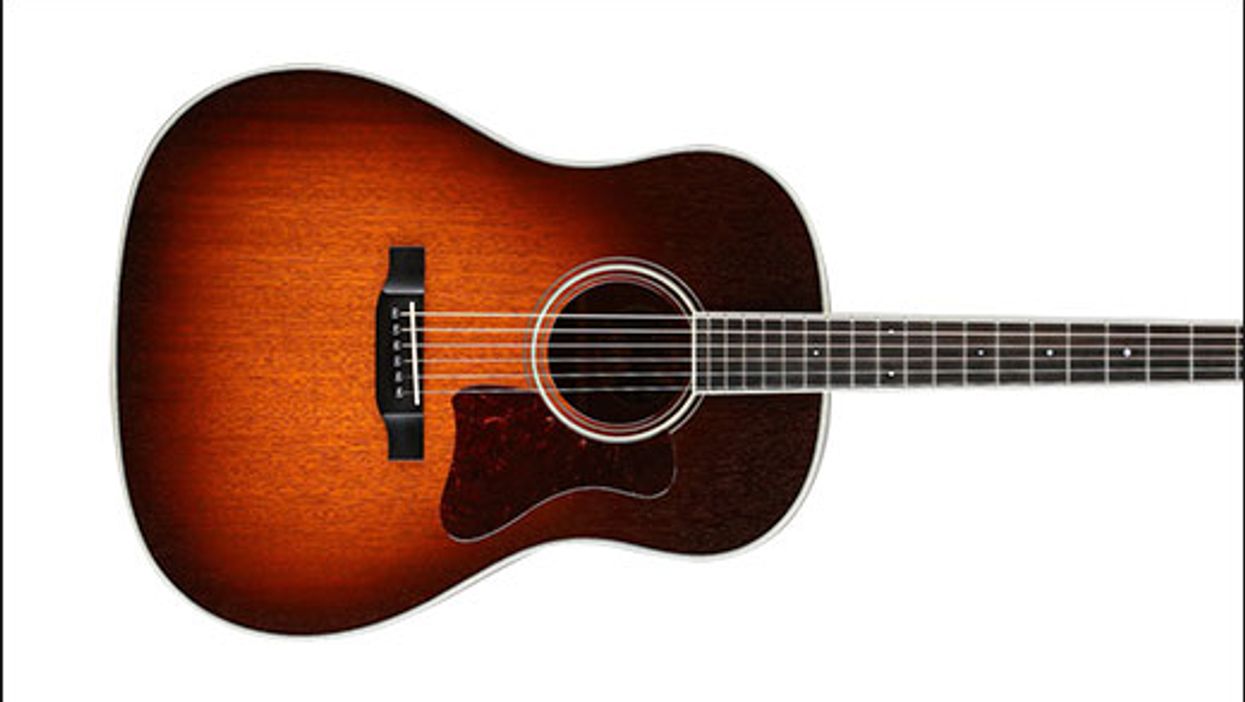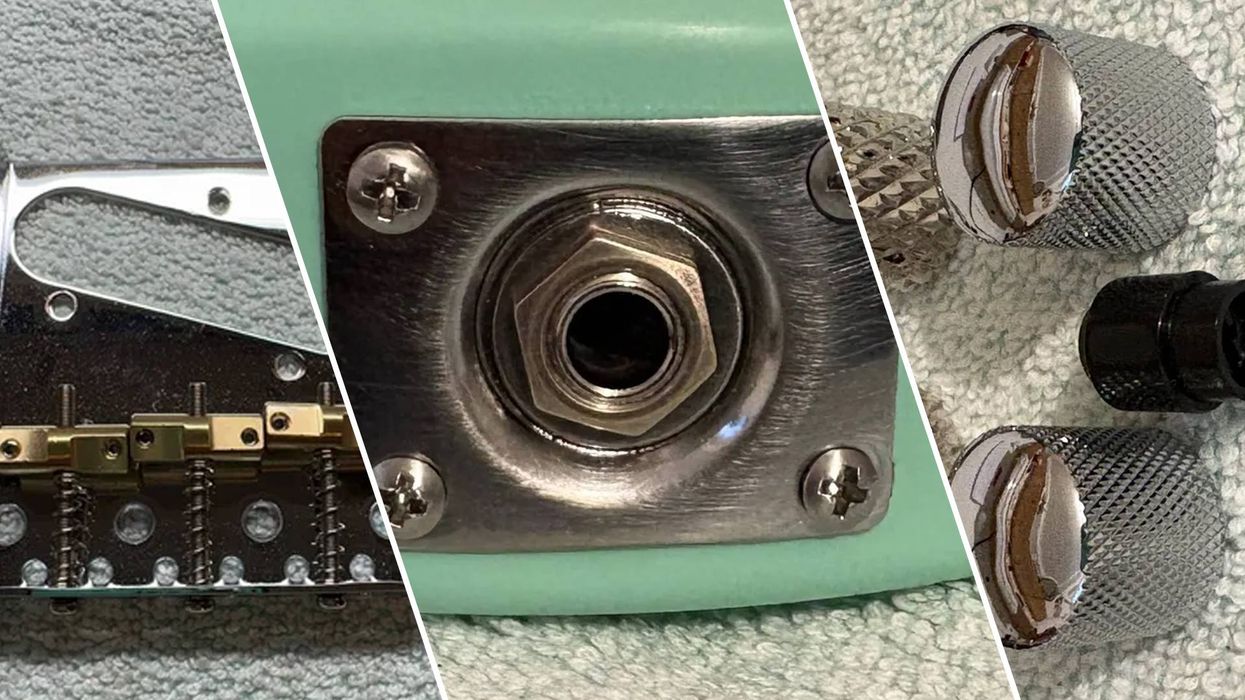Despite the round-shouldered dreadnought's prominent role in Gibson catalogs from the 1930s through the 1950s, its parent company dropped the body shape in favor of the square-shouldered dreadnought by 1970. This left Gibson's original dreadnought shape absent from new guitar displays for over a dozen years, and even before the now-infamous “guitar drought" of the early 1980s, it was essentially little more than a jumbo dinosaur.
But the increased interest in vintage guitars kept it from being forgotten, especially as Gibson's Advanced Jumbo of the late 1930s took its rightful place as a high point of American “pre-war" flattop guitar design. With the rise of independent guitarmakers in the mid 1980s, it was only a matter of time before some luthiers stretched beyond herringbone dreadnoughts and turned their sights from Nazareth, Pennsylvania, to Kalamazoo, Michigan. You didn't see many new sunburst acoustics back then from individual builders, but if you were going to use Gibson's Advanced Jumbo for inspiration, the final product better be a 'burst, and luthier exhibitions soon became a bit more colorful.
The most prominent of these early efforts to recapture the Advanced Jumbo's magic was prompted by George Gruhn—long a champion of the Gibson originals. In 1988, Gruhn ordered a batch of two dozen guitars from a young luthier in Austin named Bill Collings, who was then working with just one assistant. The Gruhn-labeled, Collings-built reissue of the Advanced Jumbo gave both Collings and the model national exposure, making the term “AJ" almost as familiar as “herringbone."
The round-shouldered dreadnought's return took full flight in 1989, when the recently restructured Gibson company opened its acoustic division in Bozeman, Montana. Along with reissues of the iconic J-200 and Advanced Jumbo, Gibson wisely brought back its far more affordable mahogany Southerner Jumbo, J-45, and J-50. It also introduced some lower-priced versions that were not based on historic models. With widespread distribution and aggressive promotional campaigns to place Gibson guitars in movies and TV shows, the round-shouldered dreadnought was back in the spotlight, and back on music store racks as well.
The acoustic guitar market was growing rapidly, and the rising prices for vintage Gibson guitar models sent demand for reissues of its iconic flattops into overdrive. Unfortunately, Gibson's new CEO pushed the Montana factory to meet that demand quickly, and quality control suffered, leaving the new reissues inconsistent as a result. This left a barn door-sized opportunity for smaller independent builders, and Collings Guitars was one of the first to offer its own versions of the round-shouldered dreadnought. Soon, plainer mahogany versions took their place alongside the deluxe rosewood and maple models, all under the collective CJ (Collings Jumbo) moniker.
Before the turn of the last century, the round-shouldered dreadnought had rebounded past any danger of extinction, but as the body shape stretched far beyond Gibson's borders, there was lingering confusion over what to call it. In Gruhn's Guide to Vintage Guitars, the original Gibsons were described as “round-shouldered dreadnought," but somewhere in the 1990s the term “slope-shouldered dreadnought" gained traction, and “slope D" became a widely used shorthand. The “slope-shoulder" moniker is still used by most of the smaller acoustic guitar workshops that build their own versions, including Bourgeois, Santa Cruz, and Huss & Dalton, as well as Collings. This term is also used by the distributors of lower-priced import versions, such as Blueridge. Gibson, however, has persisted in dividing its dreadnoughts into “square-shoulder" and “round-shoulder" categories.
Scale length has been another point of confusion with new round-shouldered dreadnoughts. While all of Martin's D models were long scale (25.4") from the beginning, Gibson's earliest round-shouldered models had a 24 3/4" scale, and only the Advanced Jumbo came with the long scale. Throughout the '40s, '50s, and '60s, part of the charm of a Southerner Jumbo, J-50, or J-45 was the short scale, and there's nothing quite like the tone and playability of those deep-bodied mahogany dreadnoughts with the lower string tension and string-bending ease this scale length offers. Although Gibson's reissues stuck with the same scale length as the originals, most other makers have given round-shouldered D models the same long scale as their other dreadnoughts, leaving the short scale as an option.
Early 2019 saw the biggest increase in the number of new round-shouldered dreadnought models to hit the market, as both Martin and Taylor introduced their own, quite different, versions. Taylor actually discontinued its earlier dreadnought shape, throwing the company's considerable weight behind new Grand Pacific models featuring its new V-pattern top bracing. Martin's DSS dreadnoughts are an all-mahogany 15 Series model, plus spruce-topped versions in their 17 Series. (Martin had released a Custom Shop version in 2018.) It is perhaps fitting that these two giants of American acoustic guitar manufacturing join the ranks of those offering an alternative dreadnought shape: Martin calls theirs a D “slope-shoulder" (DSS), while Taylor refers to the Grand Pacific as a round-shouldered dreadnought. But no matter what you call it, the once-ignored “other dreadnought" is here to stay.













![Rig Rundown: Russian Circles’ Mike Sullivan [2025]](https://www.premierguitar.com/media-library/youtube.jpg?id=62303631&width=1245&height=700&quality=70&coordinates=0%2C0%2C0%2C0)





